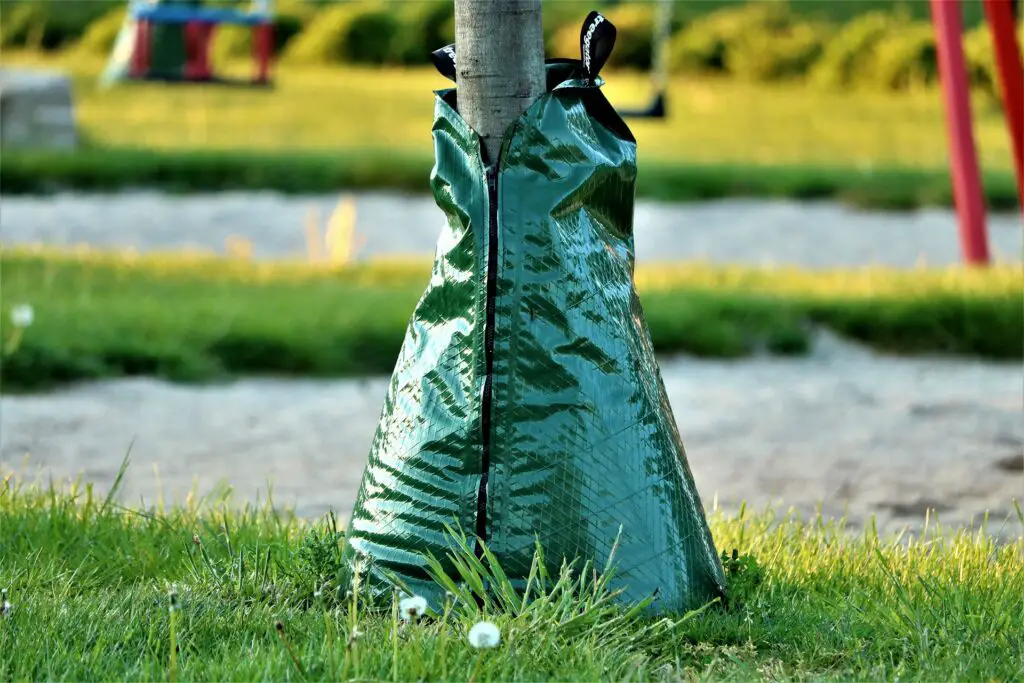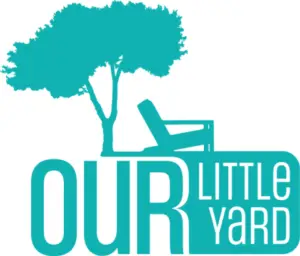Tree planting has been in full swing in the parks and public spaces in our area. Tiny, uniform trees are now dotting sidewalks in our city’s downtown. It would be a far more attractive site without all of the green plastic at the base of the new trees: Irrigation or watering bags.
These products come in 10, 15, and 20 gallon sizes and are available at all major lawn and garden stores. They can be purchased in a variety of shapes ranging from “doughnuts” to a blanket-style variety marketed as a “gator”. Irrigation bags release small amounts of water over long periods of time, making it possible for landscapers to go longer intervals without tending to their new trees’ irrigation needs. While I am accustomed to seeing irrigation/drip bags used in large scale landscaping on large corporate office parks, college campuses, or in municipal areas, I’ve started to notice homeowners in my neighborhood using them in the drier months of the year. There is no denying that they are unsightly, but do the benefits outweigh the appearance?

Do Irrigation Bags Benefit My Trees Enough To Be Worth It?
If you are planting trees in a climate with little annual rainfall, irrigation bags can be helpful in the first few months of your tree’s life while they develop a root system in its new home. They help avoid overwatering and also underwatering. However, in most planting zones in the U.S., irrigation bags are likely not all that beneficial. I will admit, it has been unusually dry lately in our part of the country, but I don’t think the newly planted trees in my city’s downtown needed the irrigation bags. They were likely trying to hedge their investment on the newly purchased trees.
Are There Drawbacks To Using Irrigation Bags? What Are the Drawbacks?
If using irrigation bags results in less work for the property owner, why wouldn’t you at least try it? There are ample drawbacks to the health of your tree:
- Any product that is designed to cover the bottom of the tree’s trunk will cut off its exposure to sunlight and oxygen. The result is that this creates an ideal environment for mold or fungi to grow on or within the irrigation bag. Some types of mold and fungi can threaten your tree’s health but trees can survive these organisms.
- The “sock” or “gator” style bags can inadvertently divert water outside the planting hole, missing the target. This can cause the roots to grow outward, instead of downward where there is more soil nutrition.
- Many commercially available bags are easily punctured or don’t effectively drip water. This can create a continually wet environment around the base of the tree that can compromise or damage the bark.
In doing my research for this post, I found testimonies from many professional landscapers who disagreed with the viewpoint the benefits of irrigation bags were not worth the risk of damaging the health of new trees. In some cases, they were responsible for managing thousands of trees on properties and grounds that they manage, and irrigation bags were the least expensive, most efficient way to water a large amount of newly planted trees without installing more underground irrigation lines.
Is there a Better Solution to Watering New Trees Than Irrigation Bags?
For all of the reasons stated above, Dr. Linda Chalker-Scott, a horticulturist and certified arborist, advises that none of the irrigation or drip bag products are as valuable for the health of your tree as using a layer of arborist wood chips. These should be applied around the base of the trunk (not extending up the trunk). The wood chips help the soil around your trees retain moisture and provides them with essential nutrients, mimicking the ground conditions of the forest.
Using wood chips or mulch around the base of your trees is very beneficial while the trees are young and throughout the life span of your trees. You should aim for a depth of at least two inches. Check and adjust this mulch depth a few times throughout the year to make sure that you have enough. See our previous blog post titled “How Often Should You Mulch?” for more information on proper mulching around young trees and other plants.
Drip irrigation is a better solution to provide trees with metered amounts of water, discharged automatically at predetermined intervals. Obviously, this solution requires more planning, skill, and irrigation infrastructure than using irrigation bags, but will provide a better chance for success for your young trees.
As many parts of the U.S. become continually drier with climate change, my stance on using irrigation or drip bags may change. For now, however, I prefer to water new trees manually while they are establishing root systems.
When are Irrigation Bags useful?
Newly planted trees need water to establish a healthy root system. In areas where continual watering is difficult (like along the city sidewalks I mentioned earlier) or drip irrigation is not practical (like parks), using irrigation bags may be better than nothing at all. This is particularly true in desert areas, parts of the Midwest that undergo long dry spells, and other areas that can’t rely on consistent rainfall.
If used correctly, irrigation bags can do a good job at applying a high volume of water slowly and evenly, with minimal maintenance.
Using Irrigation Bags
In order to avoid some of the issues with irrigation bags detailed above, professional landscapers recommend checking the devices each time you fill them up. You’ll want to make sure that bags are draining in the manner intended by the manufacturer, and clean out debris, fungi, or mold from the bags.
Depending on the size of the bag, it will likely need to be refilled every week. I’ve often noticed bags sitting empty in public locations, so I also suspect another issue with irrigation bags is they are not refilled often enough to provide the trees with enough water.
